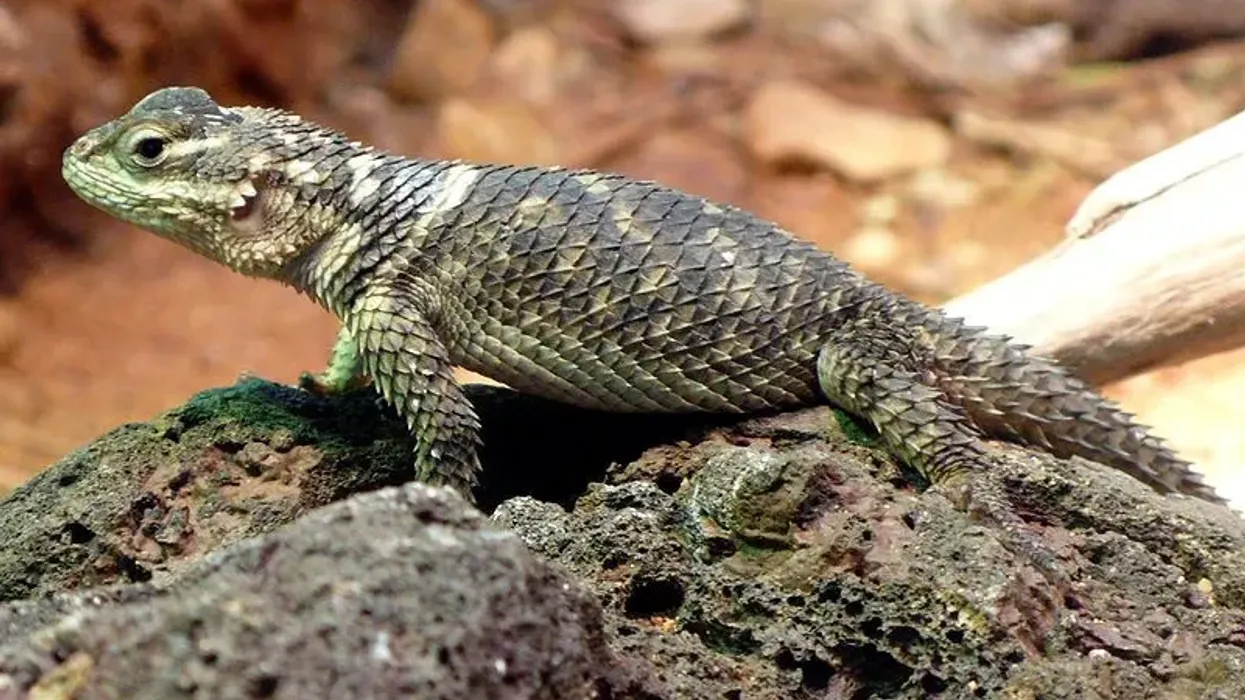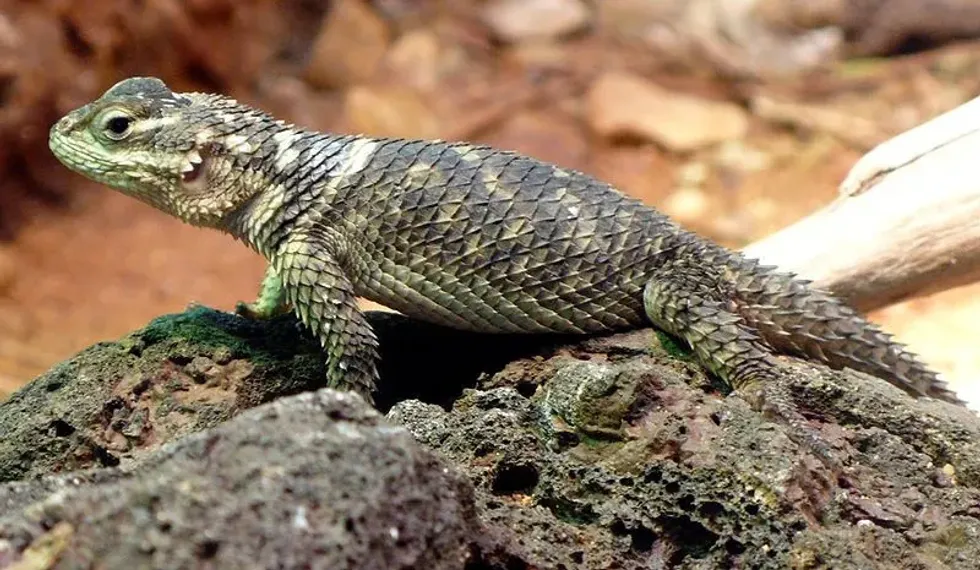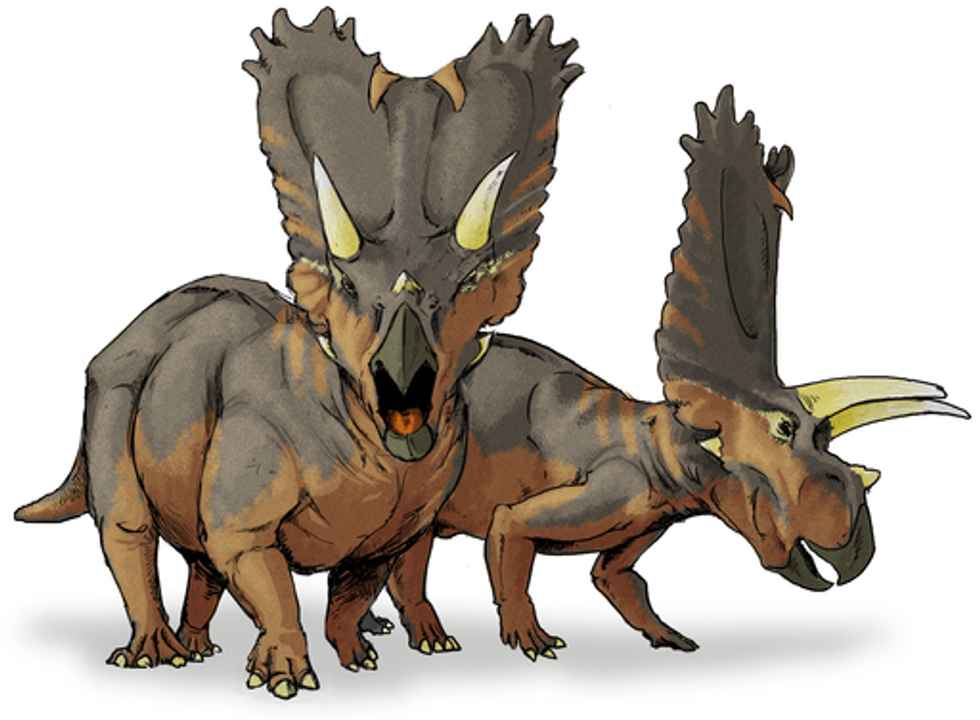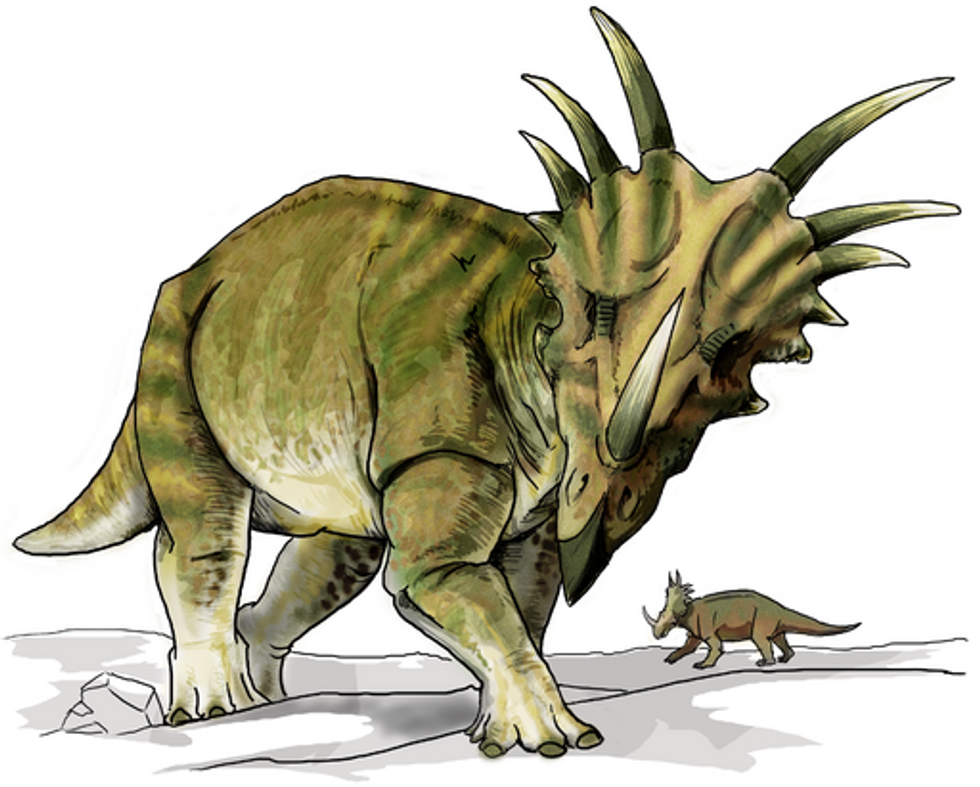One of the most beautiful and smallest species of the Phrynosomatidae family, the crevice spiny lizard (Sceloporus poinsettii) remains shy and nervous most of the time. The species is also known as the New Mexico crevice spiny lizard.
The Edwards Plateau and the Chihuahua Desert of the United States, Central Texas, and southern New Mexico are a few states where this reptile can easily be spotted. The range of this species in Mexico occurs in states such as Coahuila, Nuevo Leon, and Durango.
The New Mexico crevice spiny lizard dwells in rocky terrains of arid and semi-arid environments.
The lizard prefers limestone structures with holes and cracks. During the winter season, this species hibernates in deep crevices. The diet of this species mainly includes insects.
This species is commonly found in gray color, while some possess reddish-brown colored bodies. They have a black and white collar around their neck area and a blue spot within the collar.
Like other males of the spiny lizards' genus, the adult male crevice spiny lizards also have blue patches on both sides of the belly. The tail possesses black and white bands.
A white series of spots can be found on the head. The average snout-to-vent length is around 4.6 in (11.8 cm) while their total body length is almost 12 in (31 cm).
The International Union for Conservation of Nature has Not Evaluated the conservation status of this species.
Continue for interesting facts about the crevice spiny lizard and if you found this article interesting, don't forget to check out our other articles on the caiman lizard and the regal horned lizard.
Crevice Spiny Lizard Interesting Facts
What type of animal is a crevice spiny lizard?
The crevice spiny lizard (Sceloporus poinsettii) is a species of the Sceloporus or spiny lizard genus. People often call the species the New Mexico crevice spiny lizard. Unlike other species, the diet of the reptile sometimes also tender vegetation.
What class of animal does a crevice spiny lizard belong to?
The New Mexico crevice spiny lizard belongs to the class of Reptilia, the family of Phrynosomatidae, and the Sceloporus genus.
How many crevice spiny lizards are there in the world?
The exact population of these lizards is not known, but studies reveal that like other species of spiny lizards, the population of crevice spiny lizards is stable.
Where does a crevice spiny lizard live?
While talking about the crevice spiny lizard range, this species is found in the Edwards Plateau and the Chihuahua Desert of the United States, central Texas, and southern New Mexico. The range of this species in Mexico occurs in states such as Coahuila, Nuevo Leon, and Durango.
What is a crevice spiny lizard's habitat?
The New Mexico crevice spiny lizard dwells in rocky terrains of the arid and semi-arid environments, and the lizard prefers limestone structures with holes and cracks. During the winter season, the species hibernates in deep crevices.
Who do crevice spiny lizards live with?
These reptiles are solitary and prefer to live alone. Also, they are diurnal and remain active during the daytime. These shy reptiles usually come together during the breeding season.
How long does a crevice spiny lizard live?
The exact lifespan of this species is not known as of now, but spiny lizards generally live for around four to five years. However, they can live longer if kept in captivity.
How do they reproduce?
Very little information regarding the reproduction patterns of crevice spiny lizards (Sceloporus poinsettii) is available as of now, but it is said that this species follow the same methods as other species of the Sceloporus genus. Both male and female lizards reach sexual maturity after one to two years of birth.
Spiny lizards are polygynous which means males mate with multiple females in the breeding season. The breeding season generally occurs in the spring season and before that adult males and females perform several courtship displays.
Female crevice spiny lizards give birth to their young ones in late May or early June and around two to 11 eggs are laid in each breeding season.
What is their conservation status?
The International Union for Conservation of Nature has Not Evaluated the conservation status of the species. Apart from predation, these lizards generally have no threats.
Crevice Spiny Lizard Fun Facts
What do crevice spiny lizards look like?
This species is commonly found in gray color. They have a black and white collar around their neck area, like other males of spiny lizards genus. Adult male crevice spiny lizards also have blue patches on both sides of their bellies.
The tail possesses black and white bands. If you look closely, the dorsal body scales have black edges that help to form longitudinal black lines. Also, a white series of spots can be found on the head.
How cute are they?
The cutest thing about these lizards is their shy nature. They generally flee away to rocky crevices if someone comes near them. Also, like other male spiny lizards, adult males do push-ups and head-bobs to attract females.
How do they communicate?
Like other reptiles, these lizards follow the same methods of communication. Males are very territorial and usually puff themselves up and raise their tails to show their superiority.
During the breeding season, several courtship displays are performed. Adult males generally display their colorful throat and belly to grab the attention of their partners. Also, numerous tactile, visual, and chemical cues are used to perceive the environment.
How big is a crevice spiny lizard?
The average snout-to-vent length is around 4.6 in (11.8 cm), while their total body length is almost 12 in (31 cm). Unlike other spiny lizards, crevice spiny lizards are quite large and are five times bigger than barton springs salamanders and dwarf salamanders.
How fast can a crevice spiny lizard move?
The exact speed of this lizard is not known but the species is best known for its active and quick responses. Its vision helps this species to respond quickly.
How much does a crevice spiny lizard weigh?
The weight of the species is not known.
What are the male and female names of the species?
There are no specific names given to male and female crevice spiny lizards. Unlike males, females possess dark crossbands on their upper side.
What would you call a baby crevice spiny lizard?
No particular name is used to refer to the babies of crevice spiny lizards. People generally use terms such as juveniles and young ones to refer to the hatchlings.
What do they eat?
These lizards are insectivores and mainly prey on spiders, beetles, worms, centipedes, and several other insects. Unlike other species, the diet of the reptile sometimes also tender vegetation.
Are they dangerous?
Generally, these lizards are quite shy and do not pose any danger or threat to humans. They can attack if someone tries to harm them.
Would they make a good pet?
Yes, crevice spiny lizards can become great pets if proper care is taken.
Did you know...
Spiny lizards have the ability of cryptic coloration or camouflage that helps them to blend with the surrounding and protect themselves. Also, the spiny scales help them to prevent injuries.
Around 35 species of lizards are found in Central America.
Do crevice spiny lizards bite?
Yes, these lizards possess teeth and can bite if they feel threatened.
How to care for a crevice spiny lizard?
While talking about crevice spiny lizard care, if you provide a large cage with some rocks and a source of heat, your spiny lizard will thrive in captivity. These things are very crucial for a healthy lifestyle. One can find a spiny lizard pet in any reputable pet shop.
Here at Kidadl, we have carefully created lots of interesting family-friendly animal facts for everyone to discover! Learn more about some other reptiles from our sand lizard facts and Texas horned lizard facts pages.
You can even occupy yourself at home by coloring in one of our free printable crevice spiny lizard coloring pages.










